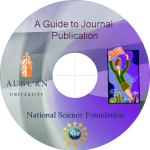

Overview of a Journal
Every journal is different but there are common features. This section defines these.
Sponsoring organization - this might be a professional society, a university or a publisher. Some journals may have multiple sponsoring organizations. Often there will be a sponsoring professional or non profit organization along with a professional publisher.
Website - each journal typically has a website, often under the master site of the sponsoring organization or publisher.
Periodic structure - journals are published periodically, such as monthly or quarterly. Each issue is numbered and the issues over a year (usually) comprise a volume. Volumes are also numbered sequentially. Each issue has page numbers (may start over each issue or may start over each volume). Each issue is dated, normally with a month or quarter and year.
Aims and scope - every journal has a mission statement which includes why it is published and the topics and areas it covers. This is found on the journal's website and often in every issue.
Editor and editorial board - this is discussed in detail in the Structure and Roles of Journal Personnel section on this CD. The editors are listed on the website and in each journal issue. These change over time. Usually their contact information (or at least institutional affiliations) is also listed.
Instructions to authors - describes how to submit a paper, what types of papers are accepted and other pertinent information about the publishing in that journal. This is found on the journal website and often in each issue.
Publishing information - covers the standard ISSN numbering, the source of printing, subscription rates and terms, legal notices on use and such things.
Table of Contents - each issue has this showing the papers and authors and any other features in that issue.
Methods of circulation - journals are traditionally print and distributed by post to subscribers including institutions and libraries. Journals are also available electronically to subscribers and to institutional users. Some journals are only available electronically.
Abstracted - journals are often abstracted by the common electronic databases such as the ISI Web of Science. This means that every article published in that journal is included in the electronic database.
